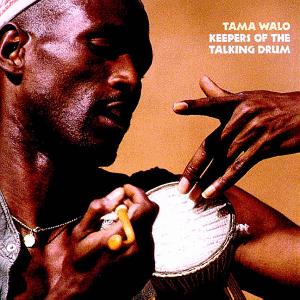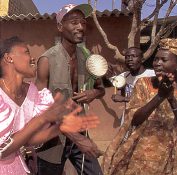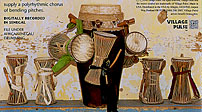
|
Tama Walo: Keepers of the Talking Drum Village Pulse VPU-1008. Compact Disc, 44:34. Recorded and produced by Carl Holm and Adam Novick in Pikine Tally Icotaff, Senegal. Liner notes. Photos. |
| Village Pulse producers
and co-founders Carl Holm and Adam Novick continue their goal of documenting drumming
styles of West Africa with this recording of tama drumming of the Walo Walo, a
Wolof people from northern Senegal. Tama Walo is an exceptional digital field
recording of breathtaking clarity and offers a glimpse of the tama in its ongoing role as
a vital element in the lives of the Walo Walo, and Senegalese in general. Popularly known as the talking drum because of its ability to mimic and articulate speech, the tama drum can be found throughout West Africa in different contexts, manifestations and names such as dundun in Nigeria (Euba 1990). The talking drum plays a crucial role in ceremonies and festivities such as weddings, life-cycle events, child-naming ceremonies, and wrestling matches. The instrument and its cultural relevance carry over into popular music genres as a marker of identity and vibrant connection between traditional practices and modernity. For example, the tama can be found in the popular music of Senegal such as mbalax (a blend of traditional Senegalese sabar drumming, Afro-Cuban music, African pop, and western pop). Likewise, the dundun in the jùjú music is prominent in Nigerian night life, ariya weddings, birthdays and funerals (Waterman 1990). Internationally, the tama can be heard in groups led by Senegalese Baaba Maal and Youssou N'Dour or in various world beat ensembles. |
|
Audio 1: "Dagagne" opening excerpt (.au, 300KB) |
The tama is an hourglass-shaped drum with a wooden body fitted on both ends with iguana skin. The iguana drum heads are laced together by strings which run along the length of the drum. The drum's wide tonal range is changed by the arm squeezing the strings while held under the armpit, as in Audio 1 (see front cover). |
| Ensemble Tama Walo plays
five tama drums of various sizes and an upright bass drum (lambe). No more than
five tama players play at one time, sometimes including three singers. The principal
soloist is Papa Thiam who studied under Yamar Thiam, father of Assane Thiam, Youssou
N'Dour's tama player. All Tama Walo drummers are griots who live and perform in Dakar,
Senegal and environs, playing for ceremonies, wrestling matches, and parties. Keepers of the Talking Drum possesses three strong qualities: content, fidelity, and layout. The producers have attempted to rectify inadequate liner notes in their previous recordings of Senegambian drumming as seen in African Percussion: Madadou Ly, Mandinka Drum Master (Village Pulse VP-1001), Tabala Wolof: Sufi Drumming of Senegal (Village Pulse VP-1002), and Sabar Wolof: Dance Drumming of Senegal (Village Pulse VP-1003). While all recordings have remarkable digital fidelity, their notes have been inconsistent. For example, Tabala Wolof clearly identifies the tracks that were recorded at actual ceremonies, whereas in Tama Walo and Sabar Wolof there is sketchy information about which tracks if any were recorded at actual events. Even though the notes for Tama Walo lack important information for scholars such as in-depth song analysis, it is by far the most informed and comprehensive release of the four. The selections are of suitable length, varying from two to ten minutes. One problem, however, is that some tracks are excerpts that fade in; therefore, the listener is unable to gauge accurately song construction. Is this because pieces run seamlessly together and it was difficult to separate them out, or were the best sections of a piece chosen? The inclusion of different versions of pieces is valuable, allowing for comparison of performances, such as two "Ganass" and three "Bak." |
|
Audio 2: "Bak" excerpt (.au, 351KB) |
The "Bak," which are pieces for listening as opposed to dancing, feature different soloists over medium-tempo grooves, so the textures, colors, and individual styles of the drummers may be more easily heard (Audio 2). Additionally, the "Bak" on Tama Walo can be compared to two "Bak" on Sabar Wolof. |
| The issue of audience
participation still needs to be addressed, since drumming, dance, hand-clapping, and
singing are intimately bound up with one another. How can emic criteria of what is good
and bad be made known to listeners outside of the culture without hearing the approval or
disapproval of participants? The logistical complexities of recording audience
participation in the field are great, and are one of the great obstacles that remote
recording engineers face. Perhaps Village Pulse will be
able to resolve this problem as technology advances. However, it is still necessary to
attempt to attempt to inform the listener of the dynamics of the event. The producers have
come up with some interesting ways to represent the communication between audience and
drummers by beefing up their liner note content and maximizing the value of photographs
within the constraints of a six-page booklet. Liner notes are in English with some Wolof occasionally phonetically spelled as in the names of the artists and drum praises. Notes are divided into sections describing
|
|
| The booklet front cover at the top of this review features a full-size close-up of Papa Thiam playing the tama. Inside pages include small black-and-white photographs showing four drummers leading a procession to a child-naming ceremony and two photos of women dancing and watching the ceremony. Additionally, there are two small color photos of a drummer and drums and the recording session, and, on the booklet rear cover (left), a full-size color photo of the leader, Papa Thiam, with dancers and drummer. | |
| The CD rear tray (left) features a photograph of the drums. These photos and their placement illustrate a well-executed presentation of drummers, audience, performance context, and instruments in an age where the compact size of CDs has limited the visual experience of enjoying an album as was the case with LPs. | |
| Keepers of the Talking Drum is a valuable addition to recorded documentation of traditional practices in West Africa and how those practices sustain their value as an important means for negotiating identity. This is perhaps the first internationally-published recording of a Walo Walo tama group. The CD represents an interesting relationship between societies with different technologies. First, the product is available only on CD, which makes it inaccessible to most Senegalese who live in a cassette culture. Cassette copies may be sold in local markets, thus denying artists their royalties. However, Senegalese are able to hear these performers live and hire them to fulfill important social functions. Second, the tama has become a part of world beat music, and as such it is a treat to hear an ensemble playing music based on a traditional practice three-and-a-half centuries old. | |
Audio 5: "Tagoumbar" excerpt (.au, 376 KB)
|
Third, the CD allows the artists to
reach out and close geographical and cultural distances, as when Papa Thiam drums and
sings, "Toubob [foreigner], American, how are you?" (Audio 5).
This excerpt reflects the ways that, as cosmopolitans, the ensemble Tama Walo dissolve
those binaries of rural/urban and First World/Third World. |
| Through CD technology and
the increased flow of information and products, Thiam is able to greet listeners far away.
He does this via a music that assists people in negotiating their lives in one of the
largest metropolitan centers in West Africa. Thiam's primary audience may be the large
migrant group of Walo Walo in Dakar, but he is clearly aware of the audience abroad who
will hear his drumming. Therefore, when he sings to the toubab, he establishes a
connection that brings listeners closer to a traditional music practice that is not an
ancient artifact but an essential part of cosmopolitan life in Dakar. Timothy R. Mangin |
|
| References Euba, Akin 1990 Yoruba Drumming: The Dundun Tradition. African Studies Series. Lagos: Elekoto Music Centre. Waterman, Christopher. 1990. Jùjú: A Social History and Ethnography of an African Popular Music. Chicago Studies in Ethnomusicology. Chicago: University of Chicago Press. |
|
|
EOL 5 | email author | email review editor 16 January, 2000 |
|

